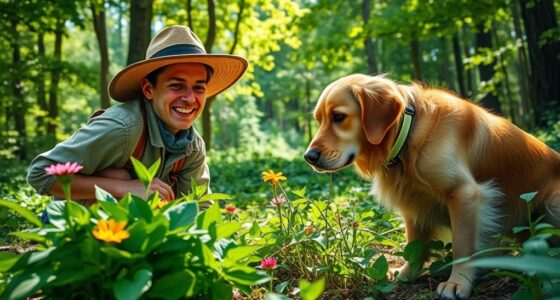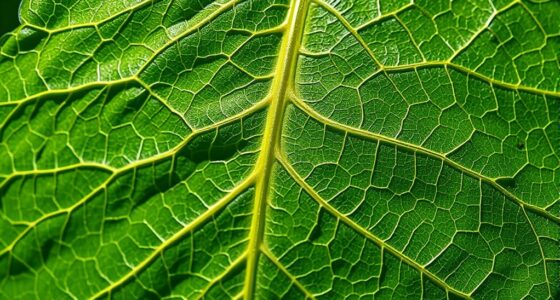As you venture into Vermont's vibrant landscape, you're surrounded by a treasure trove of wild edibles, from juicy blueberries to tangy elderberries, waiting to be discovered and savored. To forage for these wild foods, start by identifying edible species like violets and dandelions, and learn about sustainable harvesting practices. Understand the seasonal availability of these plants and plan your foraging trips accordingly. With the right knowledge and precautions, you'll be able to enjoy the flavors and nutrients of Vermont's edible landscape while preserving the environment. Continue on this path to uncover the secrets of Vermont's wild edibles. As you deepen your understanding of foraging, you may want to explore other regions rich in wild edibles, such as the diverse **edible landscapes in Georgia**, which offer delights like muscadine grapes and wild persimmons. Each area has its unique array of plants, many of which require careful attention to local ecosystems and cultural traditions. By expanding your knowledge beyond Vermont, you’ll be able to appreciate the richness of nature’s bounty across different climates and regions.
Key Takeaways
- Develop a keen eye for detail to confidently identify and forage for Vermont's diverse native edible plants like blueberries and elderberries.
- Understand the seasonal availability of wild foods in Vermont, as different plants thrive during specific times of the year.
- Adopt sustainable harvesting methods that prioritize the environment, leaving enough plants for natural replenishment and considering animal access to food sources.
- Consult reliable resources for accurate plant identification, and be aware of toxic look-alikes to prevent accidental poisoning.
- Practice mindful environmental impact practices, respecting the environment and land while foraging, and appreciating the flavors and nutrients of wild edibles.
Understanding Native Edible Plants
You'll find that Vermont is home to a diverse array of native edible plants, including blueberries, elderberries, and wild strawberries, which offer a wealth of culinary potential and nutritional benefits.
As you explore Vermont's edible landscape, you'll discover that these local species aren't only delicious but also play an important role in supporting biodiversity and cultural significance.
To guarantee the long-term preservation of these native edibles, it's vital to adopt sustainable harvesting practices and develop a deep understanding of local species. By doing so, you'll be contributing to conservation efforts and promoting environmental stewardship.
As you forage for wild foods, remember that seasonal awareness is key to proper identification and responsible harvesting. By respecting the natural cycles of Vermont's ecosystem, you'll be able to enjoy the culinary potential of native edible plants while supporting wildlife habitat and aligning with environmental and health goals.
Identifying Edible Species Safely

As you begin to forage for wild edibles in Vermont, it's important to identify the species safely to avoid any potential risks.
You'll want to know your plants inside and out, so take the time to inspect each one carefully before eating.
Know Your Plants
To confidently forage for wild edibles in Vermont, start by developing a keen eye for detail. Identifying plants accurately is crucial for safe consumption. Pay attention to distinguishing features like leaf shape, color, and growth patterns to make certain you're picking the right plants.
Here are some key considerations to keep in mind:
- Consult reliable resources: Use field guides, apps, and expert opinions to verify the identity of wild edibles before consumption.
- Be aware of toxic look-alikes: Learn to differentiate edible species from their toxic doppelgangers to prevent accidental poisoning.
- Consider habitat and season: Take note of the environment and time of year in which the plant grows to narrow down your identification.
Inspect Before Eating
When foraging for wild edibles in Vermont, it's important to carefully inspect each plant before eating, making sure you've accurately identified the species and avoided any toxic look-alikes. Proper identification is vital for safe foraging, and it's important to take a cautious approach.
Look for distinguishing features such as leaf shape, color, and growth pattern to identify edible species. Utilize guidebooks, online resources, and local experts to help with plant identification. Avoid plants with toxic lookalikes and always cross-reference multiple sources for accurate identification.
Remember, taking a cautious approach and learning to recognize edible plants can prevent accidental ingestion of harmful species. Don't rely on assumption or guesswork – inspect before eating. Wild plants can be deceiving, and harmful species can mimic edible ones.
Seasonal Availability and Harvesting

You'll need to plan your foraging excursions according to Vermont's seasonal offerings, as the state's edible landscape transforms dramatically throughout the year. Understanding the seasonal availability of wild foods is essential for successful foraging in Vermont. Different plants thrive during specific times of the year, and harvesting them at the best time ensures the best flavor and texture.
Here are three key things to keep in mind when planning your foraging trips in Vermont:
- Spring is prime time: Ramps, morel mushrooms, and fiddleheads are just a few of the delicious wild foods you can forage in Vermont during the spring season.
- Know your plants: Make sure you can identify the native plants you're looking for, and know when they're at their best for harvesting.
- Harvest sustainably: Mindful harvesting practices are essential for maintaining Vermont's edible landscape and ensuring that these wild foods will be available for future generations.
Preparing and Cooking Wild Edibles

With your foraged wild edibles in hand, it's time to get creative in the kitchen, where the possibilities for preparing and cooking these natural treasures are endless. You can experiment with various cooking methods, such as sautéing dryads saddle mushrooms or making nettle tea. Alternatively, you can try your hand at preservation techniques like drying, freezing, or canning to expand the shelf life of your wild edibles.
| Wild Edible | Cooking Method | Preservation Technique |
|---|---|---|
| Ramps | Sautéing | Freezing |
| Oyster Mushrooms | Stir-frying | Drying |
| Elderberries | Making jam | Canning |
From garlic mustard pesto to dandelion soup, the culinary potential of native edible plants in Vermont is vast. You can also preserve the flavors and nutrients of your wild edibles by making elderberry tinctures or strawberry jelly. As you explore the world of foraging, remember that the key to discovering the full potential of your wild edibles lies in experimenting with different cooking methods and preservation techniques.
Sustainable Foraging Practices

As you venture into Vermont's wilderness, it's crucial to adopt sustainable foraging practices that prioritize the well-being of the environment and local ecosystems.
You'll want to focus on respectful harvesting methods that secure the long-term health of wild plant populations, as well as consider the impact of your foraging on the surrounding environment.
Respectful Harvesting Methods
When foraging for wild foods in Vermont, make sure to adopt respectful harvesting methods that prioritize the long-term health of the ecosystem, guaranteeing a thriving environment for generations to come.
As you explore Vermont's Edible Landscape, remember that sustainable foraging practices are key to preserving wild edible plants for future generations to enjoy.
Here are three essential tips to keep in mind:
- Leave enough for replenishment: Make certain that you leave enough plants to allow for natural replenishment, maintaining the ecosystem's delicate balance.
- Consider animal access: Be mindful of animals that rely on the same food sources, ensuring they've access to the resources they need.
- Practice reciprocity: Embody the principles of the Honorable Harvest, cultivating respect, reciprocity, and gratitude towards the environment, as inspired by authors like Robin Wall Kimmerer in 'Braiding Sweetgrass'.
Mindful Environmental Impact
By embracing mindful environmental impact practices, you guarantee that your foraging activities contribute to the long-term health of Vermont's ecosystems, safeguarding biodiversity and ecological balance. Sustainable foraging is key to preserving the natural world, and it starts with considering the wildlife that relies on the same wild foods you're after.
By adopting the Honorable Harvest principles, you'll make sure that your foraging isn't only ethical but also respectful of the environment. Understanding the lifecycle of the plants you're harvesting is essential, as it allows you to harvest mindfully and secure long-term availability of these edible resources. This approach supports biodiversity and contributes to the health of Vermont's ecosystems.
Profiles of Notable Edible Species

You can identify ostrich fern fiddleheads, a Vermont delicacy, by their distinctive U-shaped fissure and brown tufts on the stem. These edible species are a treasure trove of nutrients and flavors, waiting to be discovered in Vermont's wilderness.
When foraging, keep an eye out for ramps, also known as wild leeks, which give off a pungent garlic and wild funk smell. Dryads saddle mushrooms are another prized find, recognizable by their shelf-like growth and watermelon rind aroma.
Some edible species are even hiding in plain sight, like violets, dandelions, and wood sorrel, which aren't only edible but also packed with vitamins, minerals, and antioxidants.
Here are three key takeaways for foraging in Vermont:
- Be mindful of your environment: Make sure to forage sustainably and respect the land.
- Know what you're looking for: Research and identify edible species before heading out.
- Eat with intention: Savor the flavors and nutrients of Vermont's wild edibles.
Frequently Asked Questions
How to Forage Wild Edible Plants?
You'll start by identifying the easiest wild edibles, like ramps and ostrich ferns, and then learn about their habitats and features to find them successfully, practicing sustainable harvesting to enjoy your finds in delicious recipes.
Can You Forage in Vermont?
"Fasten your medieval foraging belt, because yes, you can forage in Vermont! With public lands open to foraging, you'll find a treasure trove of wild edibles just waiting to be discovered and devoured."
How Do Beginners Do Forage?
You start by learning one wild edible at a time, using field guides and online resources to aid in identification. You join local foraging groups or workshops to gain hands-on experience and focus on easy-to-identify plants.
What Is the Foraging Rule?
You'll be surprised to know that 80% of the world's biodiversity is found in wild foods! The Foraging Rule is simple: harvest sustainably, leaving enough for nature to replenish, and consider local wildlife, ensuring a healthy environment for all.
Conclusion
As you wander through Vermont's lush landscape, remember that the wild edibles you've discovered are just the tip of the forest's culinary iceberg. With every bite, savor the flavors of the Green Mountain State's secrets, and respect the land that shares its bounty with you.
As you forage, become one with the earth, and let the ancient wisdom of the wild guide your journey, nourishing both body and soul.










